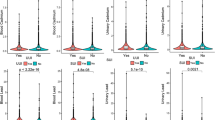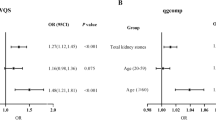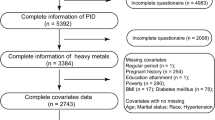Abstract
There is limited evidence linking exposure to heavy metals, especially mixed metals, to stress urinary incontinence (SUI). This study aimed to explore the relationship between multiple metals exposure and SUI in women. The data were derived from the National Health and Nutrition Examination Survey (NHANES), 2007–2020. In the study, a total of 13 metals were analyzed in blood and urine. In addition, 5155 adult women were included, of whom 2123 (41.2%) suffered from SUI. The logistic regression model and restricted cubic spline (RCS) were conducted to assess the association of single metal exposure with SUI risk. The Bayesian kernel machine regression (BKMR) and weighted quantile sum (WQS) were used to estimate the combined effect of multiple metals exposure on SUI. First, we observed that blood Pb, Hg and urinary Pb, Cd were positively related to SUI risk, whereas urinary W was inversely related by multivariate logistic regression (all p-FDR < 0.05). Additionally, a significant non-linear relationship between blood Hg and SUI risk was observed by RCS analysis. In the co-exposure models, WQS model showed that exposure to metal mixtures in blood [OR (95%CI) = 1.18 (1.06, 1.31)] and urine [OR (95%CI) = 1.18 (1.03, 1.34)] was positively associated with SUI risk, which was consistent with the results of BKMR model. A potential interaction was identified between Hg and Cd in urine. Hg and Cd were the main contributors to the combined effects. In summary, our study indicates that exposure to heavy metal mixtures may increase SUI risk in women.




Similar content being viewed by others
Data availability
The datasets analyzed during the current study are openly available in https://www.cdc.gov/nchs/nhanes/.
References
Abufaraj, M., Xu, T., Cao, C., Siyam, A., Isleem, U., Massad, A., Soria, F., Shariat, S. F., Sutcliffe, S., & Yang, L. (2021). Prevalence and trends in urinary incontinence among women in the United States, 2005–2018. American Journal of Obstetrics and Gynecology, 225(2), 166e1–166e12. https://doi.org/10.1016/j.ajog.2021.03.016.
Bai, J., Ma, Y., Zhao, Y., Yang, D., Mubarik, S., & Yu, C. (2022). Mixed exposure to phenol, parabens, pesticides, and phthalates and insulin resistance in NHANES: A mixture approach. The Science of the Total Environment, 851(Pt 2), 158218. https://doi.org/10.1016/j.scitotenv.2022.158218.
Bobb, J. F., Claus Henn, B., Valeri, L., & Coull, B. A. (2018). Statistical software for analyzing the health effects of multiple concurrent exposures via bayesian kernel machine regression. Environmental Health: A Global Access Science Source, 17(1), 67. https://doi.org/10.1186/s12940-018-0413-y.
Carrico, C., Gennings, C., Wheeler, D. C., & Factor-Litvak, P. (2015). Characterization of Weighted Quantile Sum Regression for Highly Correlated Data in a Risk Analysis Setting. Journal of Agricultural, Biological, and Environmental Statistics, 20(1), 100–120. https://doi.org/10.1007/s13253-014-0180-3.
Castelán, F., Cuevas-Romero, E., & Martínez-Gómez, M. (2020). The expression of hormone receptors as a gateway toward understanding endocrine actions in female pelvic floor muscles. Endocrine Metabolic & Immune Disorders drug Targets, 20(3), 305–320. https://doi.org/10.2174/1871530319666191009154751.
Chen, L., Sun, Q., Peng, S., Tan, T., Mei, G., Chen, H., Zhao, Y., Yao, P., & Tang, Y. (2022a). Associations of blood and urinary heavy metals with rheumatoid arthritis risk among adults in NHANES, 1999–2018. Chemosphere, 289, 133147. https://doi.org/10.1016/j.chemosphere.2021.133147.
Chen, X., Huang, J., Liang, J., Li, L., & Deng, K. (2022b). AAssociation of serum triglyceride and stress urinary incontinence in women from the national health and nutrition examination survey: a cross-sectional study. Urology, 174, 64–69. https://doi.org/10.1016/j.urology.2022.11.011.
Chow, P. M., Chuang, Y. C., Hsu, K. C. P., Shen, Y. C., & Liu, S. P. (2022). Impact of female stress urinary incontinence on quality of life, mental health, work limitation, and healthcare seeking in China, Taiwan, and South Korea (LUTS Asia): Results from a cross-sectional, population-based study. International Journal of Women’s Health, 14, 1871–1880. https://doi.org/10.2147/IJWH.S383651.
Coyne, K. S., Kvasz, M., Ireland, A. M., Milsom, I., Kopp, Z. S., & Chapple, C. R. (2012). Urinary incontinence and its relationship to mental health and health-related quality of life in men and women in Sweden, the United Kingdom, and the United States. European Urology, 61(1), 88–95. https://doi.org/10.1016/j.eururo.2011.07.049.
Dou, Y., Yin, Y., Li, Z., Du, J., Jiang, Y., Jiang, T., Guo, W., Qin, R., Li, M., Lv, H., Lu, Q., Qiu, Y., Lin, Y., Jin, G., Lu, C., Ma, H., & Hu, Z. (2022). Maternal exposure to metal mixtures during early pregnancy and fetal growth in the Jiangsu Birth Cohort, China. Environmental Research, 215(Pt 2), 114305. https://doi.org/10.1016/j.envres.2022.114305.
Duan, W., Xu, C., Liu, Q., Xu, J., Weng, Z., Zhang, X., Basnet, T. B., Dahal, M., & Gu, A. (2020). Levels of a mixture of heavy metals in blood and urine and all-cause, cardiovascular disease and cancer mortality: A population-based cohort study. Environmental pollution (Barking, Essex: 1987), 263(Pt A), 114630. https://doi.org/10.1016/j.envpol.2020.114630.
Dutta, S., Gorain, B., Choudhury, H., Roychoudhury, S., & Sengupta, P. (2022). Environmental and occupational exposure of metals and female reproductive health. Environmental Science and Pollution Research International, 29(41), 62067–62092. https://doi.org/10.1007/s11356-021-16581-9.
Elwej, A., Ghorbel, I., Chaabane, M., Soudani, N., Mnif, H., Boudawara, T., Zeghal, N., & Sefi, M. (2018). Zinc and selenium modulate barium-induced oxidative stress, cellular injury and membrane-bound ATPase in the cerebellum of adult rats and their offspring during late pregnancy and early postnatal periods. Archives of Physiology and Biochemistry, 124(3), 237–246. https://doi.org/10.1080/13813455.2017.1392579.
Huang, S., Zhong, D., Lv, Z., Cheng, J., Zou, X., Wang, T., Wen, Y., Wang, C., Yu, S., Huang, H., Li, L., & Nie, Z. (2022). Associations of multiple plasma metals with the risk of metabolic syndrome: A cross-sectional study in the mid-aged and older population of China. Ecotoxicology and Environmental Safety, 231, 113183. https://doi.org/10.1016/j.ecoenv.2022.113183.
Kiani, B., Hashemi Amin, F., Bagheri, N., Bergquist, R., Mohammadi, A. A., Yousefi, M., Faraji, H., Roshandel, G., Beirami, S., Rahimzadeh, H., & Hoseini, B. (2021). Association between heavy metals and colon cancer: An ecological study based on geographical information systems in North-Eastern Iran. BMC cancer, 21(1), 414. https://doi.org/10.1186/s12885-021-08148-1.
Kim, M. M., & Kreydin, E. I. (2018). The association of serum testosterone levels and urinary incontinence in women. The Journal of Urology, 199(2), 522–527. https://doi.org/10.1016/j.juro.2017.08.093.
Kravchenko, J., Darrah, T. H., Miller, R. K., Lyerly, H. K., & Vengosh, A. (2014). A review of the health impacts of barium from natural and anthropogenic exposure. Environmental Geochemistry and Health, 36(4), 797–814. https://doi.org/10.1007/s10653-014-9622-7.
Liu, C., Wang, Y., Li, Y., Tang, J., Hong, S., & Hong, L. (2022). Dimethyl fumarate ameliorates stress urinary incontinence by reversing ECM remodeling via the Nrf2-TGF-β1/Smad3 pathway in mice. International Urogynecology Journal, 33(5), 1231–1242. https://doi.org/10.1007/s00192-021-05061-w.
Lu, Y., Zhang, Y., Guan, Q., Xu, L., Zhao, S., Duan, J., Wang, Y., Xia, Y., & Xu, Q. (2022). Exposure to multiple trace elements and miscarriage during early pregnancy: A mixtures approach. Environment International, 162, 107161. https://doi.org/10.1016/j.envint.2022.107161.
Lukacz, E. S., Santiago-Lastra, Y., Albo, M. E., & Brubaker, L. (2017). Urinary incontinence in women. A Review JAMA, 318(16), 1592–1604. https://doi.org/10.1001/jama.2017.12137.
Matsumoto, T., Hatakeyama, S., Imai, A., Tanaka, T., Hagiwara, K., Konishi, S., Okita, K., Yamamoto, H., Tobisawa, Y., Yoneyama, T., Yoneyama, T., Hashimoto, Y., Koie, T., Nakaji, S., & Ohyama, C. (2019). Relationship between oxidative stress and lower urinary tract symptoms: Results from a community health survey in Japan. BJU International, 123(5), 877–884. https://doi.org/10.1111/bju.14535.
Metryka, E., Chibowska, K., Gutowska, I., Falkowska, A., Kupnicka, P., Barczak, K., Chlubek, D., & Baranowska-Bosiacka, I. (2018). Lead (pb) exposure enhances expression of factors Associated with inflammation. International Journal of Molecular Sciences, 19(6), 1813. https://doi.org/10.3390/ijms19061813.
Middleton, D. R., Watts, M. J., Lark, R. M., Milne, C. J., & Polya, D. A. (2016). Assessing urinary flow rate, creatinine, osmolality and other hydration adjustment methods for urinary biomonitoring using NHANES arsenic, iodine, lead and cadmium data. Environmental Health: A Global Access Science Source, 15(1), 68. https://doi.org/10.1186/s12940-016-0152-x.
Ni, J., Li, Z., Lu, Y., Zhang, H., Wang, G., Xie, J., Xie, J., Wang, Y., Zhang, Y., Wang, K., Mao, W., & Peng, B. (2022). Relationship between exposure to cadmium, lead, and mercury and the occurrence of urinary incontinence in women. Environmental Science and Pollution Research International, 29(45), 68410–68421. https://doi.org/10.1007/s11356-022-20598-z.
Niks, D., & Hille, R. (2019). Molybdenum- and tungsten-containing formate dehydrogenases and formylmethanofuran dehydrogenases: Structure, mechanism, and cofactor insertion. Protein Science: A Publication of the Protein Society, 28(1), 111–122. https://doi.org/10.1002/pro.3498.
Orr, S. E., & Bridges, C. C. (2017). Chronic kidney disease and exposure to Nephrotoxic metals. International Journal of Molecular Sciences, 18(5), 1039. https://doi.org/10.3390/ijms18051039.
Pang, H., Lv, J., Xu, T., Li, Z., Gong, J., Liu, Q., Wang, Y., Wang, J., Xia, Z., Li, Z., Li, L., & Zhu, L. (2022a). Incidence and risk factors of female urinary incontinence: A 4-year longitudinal study among 24 985 adult women in China. BJOG: An International Journal of Obstetrics and Gynaecology, 129(4), 580–589. https://doi.org/10.1111/1471-0528.16936.
Pang, H., Xu, T., Li, Z., Gong, J., Liu, Q., Wang, Y., Wang, J., Xia, Z., & Zhu, L. (2022b). Remission and transition of female urinary incontinence and its subtypes and the impact of body Mass Index on this progression: A Nationwide Population-based 4-Year longitudinal study in China. The Journal of Urology, 208(2), 360–368. https://doi.org/10.1097/JU.0000000000002686.
Qin, G., Niu, Z., Yu, J., Li, Z., Ma, J., & Xiang, P. (2021). Soil heavy metal pollution and food safety in China: Effects, sources and removing technology. Chemosphere, 267, 129205. https://doi.org/10.1016/j.chemosphere.2020.129205.
Rahman, Z., & Singh, V. P. (2019). The relative impact of toxic heavy metals (THMs) (arsenic (as), cadmium (cd), chromium (cr)(VI), mercury (hrsg.), and lead (pb)) on the total environment: An overview. Environmental Monitoring and Assessment, 191(7), 419. https://doi.org/10.1007/s10661-019-7528-7.
Rana, M. N., Tangpong, J., & Rahman, M. M. (2018). Toxicodynamics of lead, Cadmium, Mercury and Arsenic- induced kidney toxicity and treatment strategy: A mini review. Toxicology Reports, 5, 704–713. https://doi.org/10.1016/j.toxrep.2018.05.012.
Rehman, K., Fatima, F., Waheed, I., & Akash, M. S. H. (2018). Prevalence of exposure of heavy metals and their impact on health consequences. Journal of Cellular Biochemistry, 119(1), 157–184. https://doi.org/10.1002/jcb.26234.
Shrier, I., & Platt, R. W. (2008). Reducing bias through directed acyclic graphs. BMC Medical Research Methodology, 8, 70. https://doi.org/10.1186/1471-2288-8-70.
Sun, Y., Zhou, Q., & Zheng, J. (2019). Nephrotoxic metals of cadmium, lead, mercury and arsenic and the odds of kidney stones in adults: An exposure-response analysis of NHANES 2007–2016. Environment International, 132, 105115. https://doi.org/10.1016/j.envint.2019.105115.
Sun, G., Feng, X., Yang, C., Zhang, L., Yin, R., Li, Z., Bi, X., & Wu, Y. (2020). Levels, sources, isotope signatures, and health risks of mercury in street dust across China. Journal of Hazardous Materials, 392, 122276. https://doi.org/10.1016/j.jhazmat.2020.122276.
Tao, C., Li, Z., Fan, Y., Li, X., Qian, H., Yu, H., Xu, Q., & Lu, C. (2021). Independent and combined associations of urinary heavy metals exposure and serum sex hormones among adults in NHANES 2013–2016. Environmental pollution (Barking, Essex: 1987), 281, 117097. https://doi.org/10.1016/j.envpol.2021.117097.
Wah Chu, K., & Chow, K. L. (2002). Synergistic toxicity of multiple heavy metals is revealed by a biological assay using a nematode and its transgenic derivative. Aquatic Toxicology (Amsterdam Netherlands), 61(1–2), 53–64. https://doi.org/10.1016/s0166-445x(02)00017-6.
Wang, X., Mukherjee, B., & Park, S. K. (2018). Associations of cumulative exposure to heavy metal mixtures with obesity and its comorbidities among U.S. adults in NHANES 2003–2014. Environment International, 121(Pt 1), 683–694. https://doi.org/10.1016/j.envint.2018.09.035.
Wang, K., Xu, X., Jia, G., & Jiang, H. (2020a). Risk factors for Postpartum stress urinary incontinence: A systematic review and Meta-analysis. Reproductive Sciences (Thousand Oaks Calif), 27(12), 2129–2145. https://doi.org/10.1007/s43032-020-00254-y.
Wang, X., Gao, D., Zhang, G., Zhang, X., Li, Q., Gao, Q., Chen, R., Xu, S., Huang, L., Zhang, Y., Lin, L., Zhong, C., Chen, X., Sun, G., Song, Y., Yang, X., Hao, L., Yang, H., Yang, L., & Yang, N. (2020b). Exposure to multiple metals in early pregnancy and gestational diabetes mellitus: A prospective cohort study. Environment International, 135, 105370. https://doi.org/10.1016/j.envint.2019.105370.
Wang, B., Chen, M., Ding, L., Zhao, Y., Man, Y., Feng, L., Li, P., Zhang, L., & Feng, X. (2021). Fish, rice, and human hair mercury concentrations and health risks in typical Hg-contaminated areas and fish-rich areas, China. Environment International, 154, 106561. https://doi.org/10.1016/j.envint.2021.106561.
Wang, X. X., Zhang, L., & Lu, Y. (2023). Advances in the molecular pathogenesis and cell therapy of stress urinary incontinence. Frontiers in cell and Developmental Biology, 11, 1090386. https://doi.org/10.3389/fcell.2023.1090386.
Weinberg, A. E., Leppert, J. T., & Elliott, C. S. (2015). Biochemical measures of diabetes are not independent predictors of urinary incontinence in women. The Journal of Urology, 194(6), 1668–1674. https://doi.org/10.1016/j.juro.2015.06.074.
Witkowska, D., Słowik, J., & Chilicka, K. (2021). Heavy Metals and Human Health: Possible exposure pathways and the competition for protein binding sites. Molecules (Basel Switzerland), 26(19), 6060. https://doi.org/10.3390/molecules26196060.
Wu, X., Cobbina, S. J., Mao, G., Xu, H., Zhang, Z., & Yang, L. (2016). A review of toxicity and mechanisms of individual and mixtures of heavy metals in the environment. Environmental Science and Pollution Research International, 23(9), 8244–8259. https://doi.org/10.1007/s11356-016-6333-x.
Yañez, A. J., Jaramillo, K., Blaña, C., Burgos, R. A., Isla, A., Silva, P., & Aguilar, M. (2023). Sodium Tungstate (NaW) decreases reactive oxygen species (ROS) production in cells: New Cellular antioxidant. Biomedicines, 11(2), 417. https://doi.org/10.3390/biomedicines11020417.
Yao, X., Steven Xu, X., Yang, Y., Zhu, Z., Zhu, Z., Tao, F., & Yuan, M. (2021). Stratification of population in NHANES 2009–2014 based on exposure pattern of lead, cadmium, mercury, and arsenic and their association with cardiovascular, renal and respiratory outcomes. Environment International, 149, 106410. https://doi.org/10.1016/j.envint.2021.106410.
Zhang, L., Zhu, L., Xu, T., Lang, J., Li, Z., Gong, J., Liu, Q., & Liu, X. (2015). A Population-based Survey of the prevalence, potential risk factors, and Symptom-specific Bother of Lower urinary tract symptoms in adult Chinese women. European Urology, 68(1), 97–112. https://doi.org/10.1016/j.eururo.2014.12.012.
Acknowledgements
All authors thank NHANES for providing the publicly available data.
Funding
This work was supported by the Opening Foundation of Key Laboratory (JSHD202317); Jiangsu Province Capability Improvement Project through Science, Technology and Education (ZDXYS202210); and Jiangsu Provincial Special Program of Maternal and child health (F202326).
Author information
Authors and Affiliations
Contributions
XY: Conceptualization, methodology, data curation, visualization, writing—original draft. MJ: Methodology, visualization. YD: Methodology, resources. JW: Supervision, review & editing. HJ: Conceptualization, resources, supervision, review & editing. All authors read and approved the final manuscript.
Corresponding author
Ethics declarations
Competing interests
The authors declare no competing interests.
Ethical approval
The survey was approved by the National Center for Health Statistics Ethics Review Board.
Consent to participate
Written informed consent was obtained from each participant before participation in the study.
Consent to publish
All the authors give consent for this version of the article to be published.
Additional information
Publisher’s Note
Springer Nature remains neutral with regard to jurisdictional claims in published maps and institutional affiliations.
Electronic supplementary material
Below is the link to the electronic supplementary material.
Rights and permissions
Springer Nature or its licensor (e.g. a society or other partner) holds exclusive rights to this article under a publishing agreement with the author(s) or other rightsholder(s); author self-archiving of the accepted manuscript version of this article is solely governed by the terms of such publishing agreement and applicable law.
About this article
Cite this article
Yao, X., Jiang, M., Dong, Y. et al. Association between exposure to multiple metals and stress urinary incontinence in women: a mixture approach. Environ Geochem Health 46, 149 (2024). https://doi.org/10.1007/s10653-024-01929-0
Received:
Accepted:
Published:
DOI: https://doi.org/10.1007/s10653-024-01929-0




